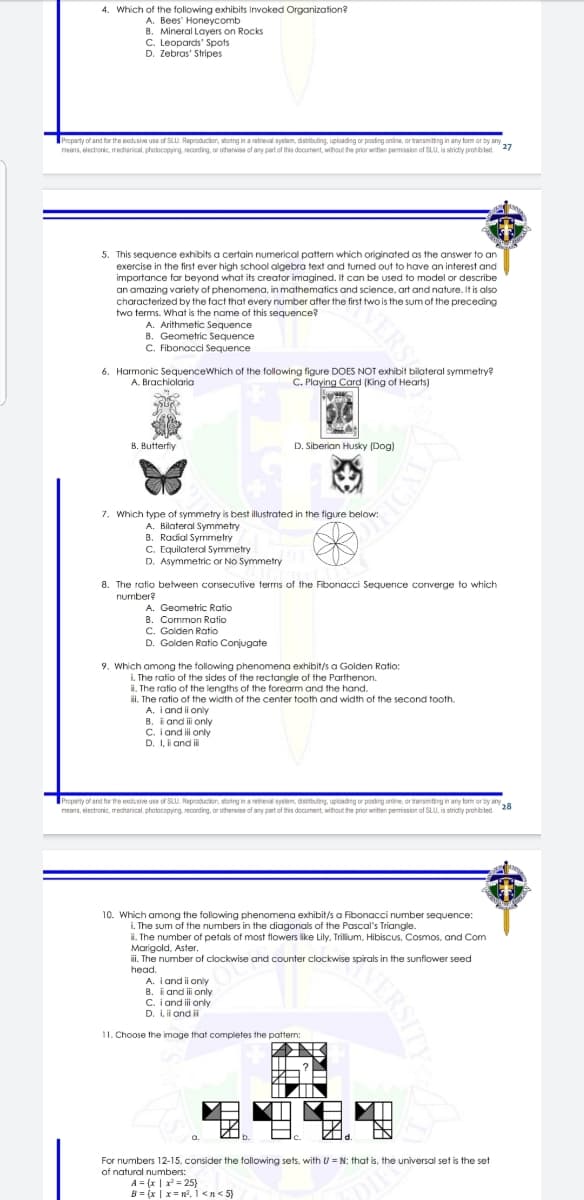Biology: The Unity and Diversity of Life (MindTap Course List)
14th Edition
ISBN:9781305073951
Author:Cecie Starr, Ralph Taggart, Christine Evers, Lisa Starr
Publisher:Cecie Starr, Ralph Taggart, Christine Evers, Lisa Starr
Chapter1: Invitation To Biology
Section: Chapter Questions
Problem 3CT: Why would you think twice about ordering from a restaurant menu that lists the specific epithet but...
Related questions
Question

Transcribed Image Text:4. Which of the following exhibits Invoked Organization?
A. Bees' Honeycomb
B. Mineral Layers on Rocks
C. Leopards' Spots
D. Zebras' Stripes
Proparty of and for the exdusive use of SLU. Reproducion, stoting in a retrieval system, distributing, uploading or posting onine, or transmiting in any form or by any
neens, electroric, medchanical, photocopying, recording, or otherwise of any part of this document, wihout the prior witten permission of SLU, is stridly prohibled. 27
5. This sequence exhibits a certain numerical pattern which originated as the answer to an
exercise in the first ever high school algebra text and turned out to have an interest and
importance far beyond what its creator imagined. It can be used to model or describe
an amazing variety of phenomena, in mathematics and science, art and nature. It is also
characterized by the fact that every number after the first two is the sum of the preceding
two terms. What is the name of this sequence?
A. Arithmetic Sequence
B. Geometric Sequence
C. Fibonacci Sequence
6. Harmonic SequenceWhich of the following figure DOES NOT exhibit bilateral symmetry?
A. Brachiolaria
C. Playing Card (King of Hearts)
B. Butterfiy
D. Siberian Husky (Dog)
7. Which type of symmetry is best illustrated in the figure below:
A. Bilateral Symmetry
B. Radial Syrrmelry
C. Equilateral Symmetry
D. Asymmetric or No Symmetry
8. The ratio between consecutive terms of the Fibonacci Sequence converge to which
number?
A. Geometric Ratio
B. Common Ratio
C. Golden Ratio
D. Golden Ratio Conjugate
9. Which among the following phenomena exhibit/s a Golden Ratio:
i. The ratio of the sides of the rectangle of the Parthenon.
i. The ratio of the lengths of the forearm and the hand.
ii. The ratio of the width of the center tooth and width of the second tooth.
A. i and i only
B. i and i only
C. i and i only
D. I, i and i
Property of and for the exdusive use of SLU. Reproducion, stoting in a retrieval system, distributing, uploading or posting onine, or transmiting in any form or by anya8
28
neans, electronic, mechanical, photocopying, recording, or otherwise of any part aof this document, without the prior wnten permission of SLU, is strictiy prohib ted.
10. Which among the following phenomena exhibit/s a Fibonacci number sequence:
i. The sum of the numbers in the diagonals of the Pascal's Triangle.
H. The number of petals of most flowers like Lily, Trillium, Hibiscus, Cosmos, and Com
Marigold, Aster.
ii. The number of clockwise and counter clockwise spirals in the sunflower seed
head.
A. i and ii only
B. i and i only
C. i and i orly
D. i, i and ii
11. Choose the image that completes the pattern:
For numbers 12-15, consider the following sets, with U = N: that is, the universal set is the set
of natural numbers:
A = (x | x = 25}
B = (x | x = n2, 1 <n< 5}
KERS
LIRSITY
Expert Solution
This question has been solved!
Explore an expertly crafted, step-by-step solution for a thorough understanding of key concepts.
This is a popular solution!
Trending now
This is a popular solution!
Step by step
Solved in 4 steps

Knowledge Booster
Learn more about
Need a deep-dive on the concept behind this application? Look no further. Learn more about this topic, biology and related others by exploring similar questions and additional content below.Recommended textbooks for you

Biology: The Unity and Diversity of Life (MindTap…
Biology
ISBN:
9781305073951
Author:
Cecie Starr, Ralph Taggart, Christine Evers, Lisa Starr
Publisher:
Cengage Learning

Anatomy & Physiology
Biology
ISBN:
9781938168130
Author:
Kelly A. Young, James A. Wise, Peter DeSaix, Dean H. Kruse, Brandon Poe, Eddie Johnson, Jody E. Johnson, Oksana Korol, J. Gordon Betts, Mark Womble
Publisher:
OpenStax College

Biology 2e
Biology
ISBN:
9781947172517
Author:
Matthew Douglas, Jung Choi, Mary Ann Clark
Publisher:
OpenStax

Biology: The Unity and Diversity of Life (MindTap…
Biology
ISBN:
9781305073951
Author:
Cecie Starr, Ralph Taggart, Christine Evers, Lisa Starr
Publisher:
Cengage Learning

Anatomy & Physiology
Biology
ISBN:
9781938168130
Author:
Kelly A. Young, James A. Wise, Peter DeSaix, Dean H. Kruse, Brandon Poe, Eddie Johnson, Jody E. Johnson, Oksana Korol, J. Gordon Betts, Mark Womble
Publisher:
OpenStax College

Biology 2e
Biology
ISBN:
9781947172517
Author:
Matthew Douglas, Jung Choi, Mary Ann Clark
Publisher:
OpenStax


Essentials Health Info Management Principles/Prac…
Health & Nutrition
ISBN:
9780357191651
Author:
Bowie
Publisher:
Cengage